Who Gets the Most Sunlight?
No matter where we live, we spend about half the year with the Sun above the horizon. But, ignoring clouds, which part of the world gets the most daylight? And which gets the least? The answers might surprise you.

Sydney, Australia, gets plenty of sunshine. Overall, however, Sydney gets less sunlight than most other towns and cities in the world. How can this be?
©iStockphoto.com/nello_granato
June Solstice: An Extreme Day, but Things Even Out
June 21, 2023, is the summer solstice and the longest day of the year for the Northern Hemisphere. At the same time, it is the winter solstice—and shortest day of the year—for the Southern Hemisphere.
The situation is reversed at the December solstice, when the amount of daylight reaches a minimum in the Northern Hemisphere, and a maximum in the Southern Hemisphere.
Over the course of a year, therefore, long days and short days balance each other out, and we all end up with roughly the same amount of sunlight: six months’ worth, or 12 hours per day on average.
“Sunlight” and “Daylight”: What Do We Mean?
- In this case, sunlight and daylight refer to the period of time the Sun is above the horizon, even if it is covered by clouds.
- If the Sun is below the horizon it is either twilight (the period of light before sunrise and after sunset) or night.
- Sunlight and daylight do not have the same meaning as sunshine, which is generally used to talk about the number of hours the Sun is free from cloud cover.
- Also, sunlight and daylight are not the same as irradiance, which is a measure of how much energy we receive from the Sun’s rays.
Comparing Daylight at Different Latitudes
In practice, however, the actual amount of sunlight you get depends on your latitude north or south of the equator. If you wanted to maximize your hours of daylight, which latitude should you move to?
The following bar chart reveals the average amount of daylight per day for every line of latitude from 90° north to 90° south. We made the chart using our sunrise and sunset data for 2023. (The shape of the chart is the same from one year to the next.)
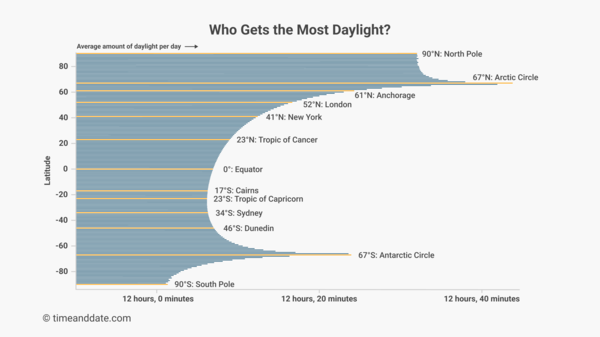

Wherever you live, you spend about half the year in daylight, where the Sun is above the horizon. On average, that’s around 12 hours of daylight per day—but the actual amount varies with latitude.
©timeanddate
In our chart, each line of latitude is represented by a horizontal bar. 90° north is at the top, the equator is in the middle, and 90° south is at the bottom. The length of each bar from left to right equals the average amount of daylight at that latitude.*
Hours and minutes of daylight per day are indicated by the numbers along the horizontal x-axis, from 12 hours, 0 minutes to 12 hours, 40 minutes.
A Spiky, Odd-Looking Chart
The above chart is perhaps not what you might expect. In particular, there are three odd features that need to be explained.
- Everywhere gets more than 12 hours of daylight per day on average.
- The amount of daylight varies from one line of latitude to the next, with sharp spikes at the Arctic Circle and the Antarctic Circle.
- The Northern Hemisphere gets more daylight than the Southern Hemisphere.
How can we explain these oddities?
1. Why More than 12 Hours of Daylight per Day on Average?
At any one moment, as Earth spins on its axis, half the planet is facing toward the Sun, and half is facing away.
In other words, half the globe is always in daylight, and half is always shielded from the Sun. So how can everywhere get more than 12 hours of daylight per day on average?
There are two reasons for this: the size of the Sun in the sky, and the bending of light in Earth’s atmosphere.
From One Edge to the Other
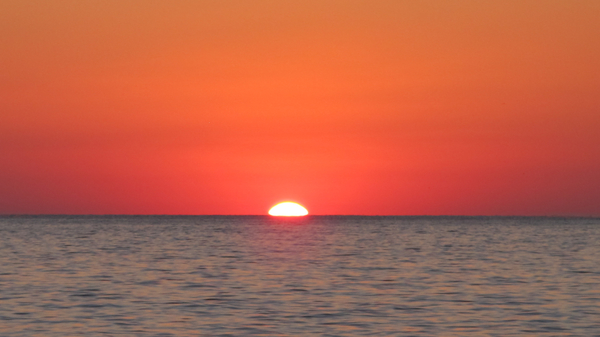
Here the Sun has risen, and we are in daylight. However, the center of the Sun’s disk is still below the horizon.
©iStockphoto.com/Tetiana Voievodenko
First, the Sun appears as a disk (like the Moon), not a point (like a star). Daylight is not measured from when the center of the Sun’s disk rises, to when the center of the Sun’s disk sets.
Instead, daylight begins a little bit early, when the top edge of the Sun first appears above the horizon. Likewise, it ends a little bit late: not until the final edge of the Sun’s disk has disappeared.
The equilux: 12 hours of day, 12 hours of night
Seeing Around a Corner
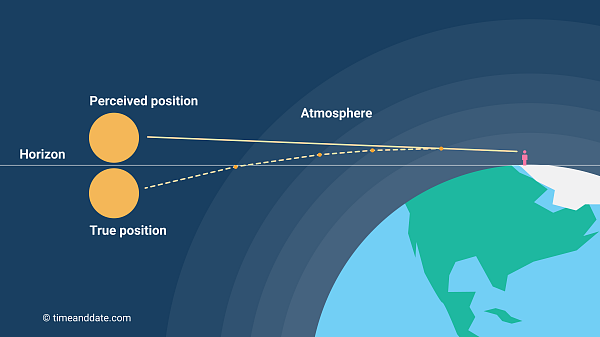
Atmospheric refraction makes objects appear higher than they really are.
©timeanddate
Second, light from the Sun is bent by Earth’s atmosphere—a phenomenon known as refraction. As a result of this optical trick, we can see the Sun even when its true position is beneath the horizon.
Again, this means that sunrise comes a little earlier than expected, and sunset a little later—giving us more daylight overall.
2. Why Does Daylight Vary with Latitude?
Earth spins on its axis with the tropics—the region of the globe that straddles the equator—pointed toward the Sun.
Therefore, around the equator, the Sun tends to rise straight upward from the horizon.
As we travel north or south from the tropics, the Sun rises at more of a slope. In the northern hemisphere, the Sun moves along the horizon from left to right at sunrise and sunset; in the southern hemisphere, it moves from right to left.
The effect of this slope is that sunrise and sunset take longer: the top edge of the Sun appears even earlier at sunrise; the bottom edge disappears even later at sunset.
Straight Up, or At an Angle?
The following images are taken from our Interactive Night Sky Map, one hour after sunrise on the June solstice.
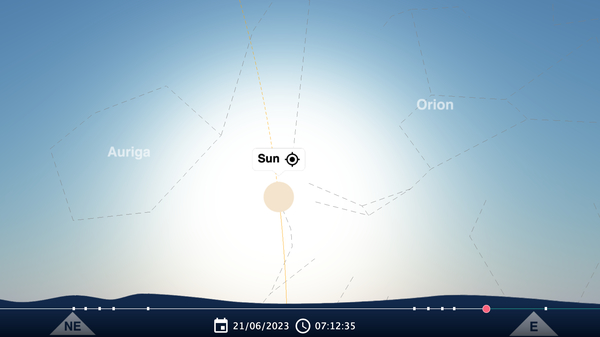
The Sun rises almost straight upward in Quito, Ecuador, a mere 20 km (12 miles) south of the equator.
©timeanddate
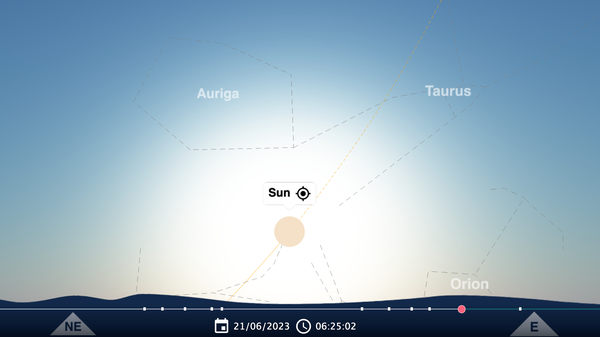
On the same day, 4500 km (2800 miles) to the north, the Sun rises at an angle in New York, USA.
©timeanddate
What’s So Special about the Arctic and Antarctic Circles?
The long sunrise and long sunset effect is most pronounced at the Arctic and Antarctic Circles. Here, around the solstices, the Sun spends a lot of time skimming along the horizon, producing more hours of sunlight throughout the year.
The Sun also skims the horizon at the North and South Poles. The difference here is that this happens around the equinoxes, not the solstices—leading to fewer hours of daylight overall.
At the equinoxes, the Sun’s position in the sky changes more quickly from one day to the next than it does at the solstices. This is why sunrise and sunset times alter rapidly during the months of March and September, but slowly during June and December.
Consequently, the Sun spends less time per year skimming the horizon at the poles than at the polar circles.
Sunrise and sunset times for your city
The Horizon-Hugging Sun
Again, these examples are taken from our Interactive Night Sky Map. To make the path of the Sun easier to see, we’ve turned off the “elevated horizon” feature.
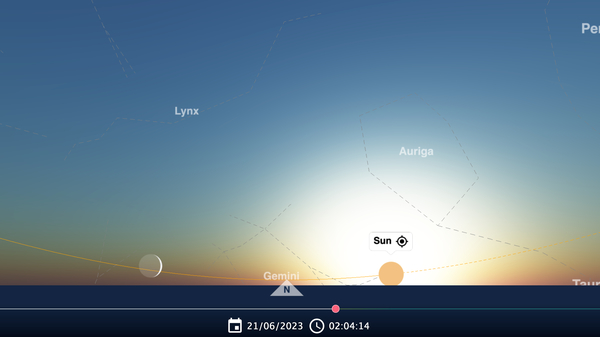
The Sun (in this case, closely followed by the Moon) swoops low along the horizon on the day of the June solstice in Bodø—a Norwegian town about 80 km (50 miles) north of the Arctic Circle.
©timeanddate
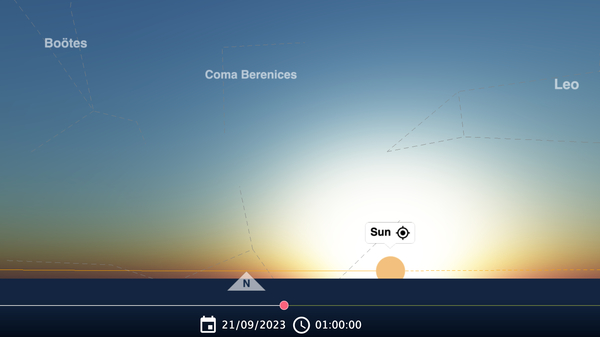
The Sun gradually sets at the North Pole in the days around the September equinox. Overall, the Sun spends less time brushing the horizon at the North Pole than it does at the Arctic Circle.
©timeanddate
3. Why Are Sunlight Levels Not the Same for Northern and Southern Hemispheres?
We all know we get the most daylight during the summer. What is less well known is that summer lasts longer in the Northern Hemisphere than the Southern Hemisphere.
The reason for this is that Earth’s orbit around the Sun is not a perfect circle. Earth is closest to the Sun in early January, and farthest from the Sun in early July.
The closer Earth is to the Sun, the more quickly it travels along its orbital path. So seasonal changes happen a bit more quickly in January, and a bit more slowly in July.
January is summer in the Southern Hemisphere, and winter in the Northern Hemisphere; in July, it’s the other way around. Thus summer lasts longer in the Northern Hemisphere—giving the northern half of the globe more sunlight than the southern half over the course of the year.
Different Lengths of Seasons
| March equinox to September equinox, 2023 |
|---|
| 186 days, 9 hours, 25 minutes |
| Northern spring & summer |
| Southern fall & winter |
| September equinox to March equinox, 2023/24 |
|---|
| 178 days, 20 hours, 16 minutes |
| Northern fall & winter |
| Southern spring & summer |
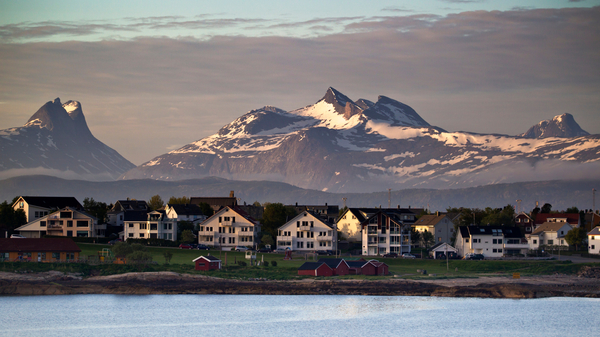
If you want to maximize your hours of daylight, head to somewhere like Bodø, Norway. At a latitude of 67.28° north, the town gets, on average, 36½ minutes of daylight per day more than Sydney, Australia, at 33.87° south. Over the course of a year, that’s about 9 days’ worth.
©iStockphoto.com/dmathies
* Our bar chart comparing daylight at different latitudes is very smooth—but you might have noticed some ‘lumpiness’ in the lengths of the bars close to the North Pole and South Pole. This is caused by jumps in the number of days of polar day (Midnight Sun) and polar night.